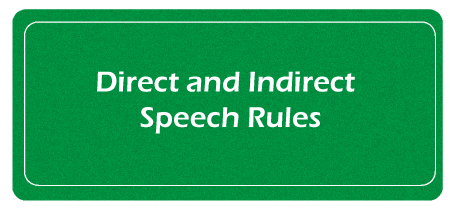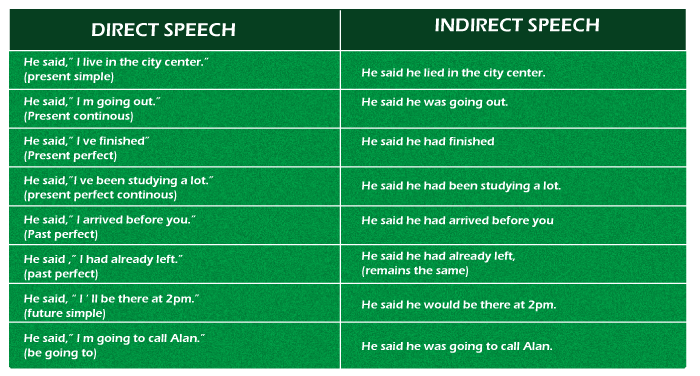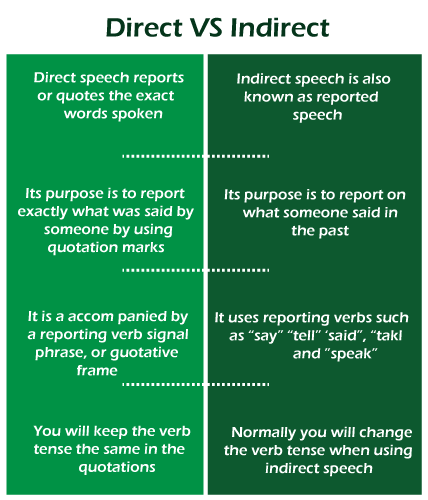Direct and Indirect Speech RulesIn our day-to-day life we use direct and Indirect speech on a regular basis. Before digging in the rules let us have a look at their meaning and definition. Direct speech is pretty self-explanatory, like statements that report an individual's thoughts precisely in their natural form. It is frequently surrounded by quotation marks to make it clear to the reader that the quoted statement is the presenter's original narration. 
Indirect speech is often termed to as reported speech, indirect narrative, or indirect discourse. In grammar, indirect speaking occurs when you recount someone else's remark in your own language without changing the statement's meaning. It is reported speech to quote someone's comments without using his own words and change the message's meaning. Rules For Direct and Indirect SpeechDirect to Indirect Speech Conversion Rules A variety of criteria are evaluated when converting a direct speech sentence to indirect speech, including reporting verbs, modals, time, place, pronouns, tenses, and so on. Read on to understand each of these elements individually. Rule 1 - Direct to Reported Speech Transformation- Reporting VerbWhenever the reporting verb in direct speech is in the past tense. Then in such a scenario all the present tenses in the reported or the indirect speech are transformed to the appropriate past tense. Example of direct to indirect speech: Direct: Helen said, 'I am glad'. Indirect: Helen said (that) she was glad. Tenses in indirect speech do not vary if the terms within the quotations (") refer to a habitual behavior or a general truth. Instance of this type of conversion is as follow ; Direct: John said, 'They cannot survive in water'. Indirect: John said that they cannot survive in water. The tense of direct speech don't alter depending on whether the reported verb is in the future tense form or the present tense form. Example of direct to indirect speech : Direct: He says/will say, 'I am heading. ' Indirect: He says/will say he is heading. Rule 2 - Convert Direct Speech to Indirect Speech - Present TenseThe Present Perfect becomes the Past Perfect. Example of direct to indirect speech : Direct: "I have been to Bulgaria", she told me. Indirect: She told me that she had been to Bulgaria. Direct to indirect speech example: Present Continuous transforms to Past Continuous Direct: "I like performing on stage", he explained. Indirect: He explained that he liked performing on stage. Present Perfect transforms into Past Perfect Direct to indirect speech examples ; Direct: John said, "Helen has completed her schoolwork ". Indirect: John said that Helen had completed her schoolwork. Simple Present to Simple Past Direct to Indirect Speech Instances ; Direct:" I am unwell, he said. Indirect: He said that he was unwell. Rule 3 - Convert Direct Speech to Indirect Speech - Past & Future TenseDirect to indirect speech instance: Simple Past to Past Perfect Direct: He said, "Richardson reached on Monday. " Indirect: He said that Richardson had reached out on Monday. Past Continuous transforms to Past Perfect Continuous Here are a few examples Direct: "We were making a painting", they told us. Indirect: They told us that they had been making the painting. Example of Future to Present Conditional Direct: He said, "I will be in Ireland on Wednesday. " Indirect: He said that he would be in Ireland on Wednesday. Future Continuous transforms to Conditional Continuous Example of direct to indirect discourse Direct: She said, "I'll be throwing away the old laptop next Wednesday. " Indirect: She said that she would be throwing away the old laptop the following Wednesday. To pass the verbal abilities, you must have a solid conceptual understanding of Direct and Indirect Speech, as well as their usage and applicability in the English language. Rule 4 - Converting the Direct Speech to Indirect Speech - Interrogative StatementsSuppose a direct speech statement starts with a question (what/where/when), then no conjunction is utilized. It is because the "question-word" serves as a connecting clause. Example of direct to indirect speech Direct: "Where do you reside?" asked the woman. Indirect: The boy inquired as to where I resided. If the first word of a direct speech statement is the auxiliary verbs/helping verbs, the connecting clause ought to be if or whether. Example of direct to indirect speech Direct: He said, 'Will you come for the conference' ? Indirect: He asked whether we would come for the conference. Reporting verbs like 'said/said to' become questioned, requested, or demanded. Example of direct to indirect discourse Direct: John said to me, 'What are you holding' ? Indirect: John asked me what I was holding. Rule 5 - From Direct to Indirect Speech Conversion - Modal ChangesWhen switching from direct to indirect speech, the modals employed in the sentences shift as follows: Could substitutes can. May is changed into Might. Must is changed to had to/would have to. Consider the following examples : Direct: Elizabeth said, 'She can sing a song'. Indirect: Elizabeth said that she could sing a song. Direct: Eloy said, 'I may purchase a suit'. Indirect: Eloy said that he might purchase a suit. Direct: Arjun said, 'I must finish the homework'. Indirect: Arjun stated that he has to finish the homework. Some modals never change: Could, Would, Should, Might, and Ought to. Direct: Kishan said, 'I should wash the dishes. ' Indirect: Kishan said that he should wash the dishes. Rule 6 - Transformation of Direct Speech to Indirect Speech - PronounsThe 1st person in direct speech transforms depending on the topic of the discourse. Here is instance of this rule, transformation/conversion. Direct: Seema said, "I am in class Tenth. " Indirect: Seema says that she was in class Tenth. The aim of reporting speech determines the second person of direct speech. Examples of direct and indirect speech - Direct: Elizabeth says to us, "You have accomplished your tasks. " Indirect: Elizabeth says to us that we have accomplished our tasks. The 3rd person of direct speech remains constant. Examples of direct and indirect speech - Direct: John says, "He skates well. " Indirect: John says that he skates well. Rule 7 - Transformation of Direct Speech to Indirect Speech - Requests, Order, Wishes, Exclamations.Some verbs that assist indirect speech include requested, ordered, suggested, and recommended. Negative sentences utilize forbid-forbade. As a result, the imperative mood in direct speech is replaced by the infinitive mood in indirect discourse. Direct: Kate said to him, 'Please fulfill it'. Indirect: Kate asked him to fulfill it. Direct: Ahmed said to Rashid, 'Take a seat. Indirect: Ahmed ordered Rashid to take a seat. Interjections are removed from exclamatory sentences that indicate pain, sorrow, delight, or applause, and the sentence is modified to an assertive statement. Direct: Sophie said, 'Alas! 'I am ruined. ' Indirect: Sophie exclaimed regrettably that she was ruined. Rule 8 - Direct Speech to Reported Speech Transformation - PunctuationThe terms actually said in direct speech must be in (") quotes and, therefore, should start with a capital letter. As an instance, she stated, "I am the strongest. " A full stop, comma, exclamation mark, or question mark is positioned within the concluding inverted commas. Instance: Group asked, "Can we dance with you? " If direct speech follows the info about who is talking, a comma precedes the initial inverted comma to initiate the speech. Instance of direct speech: William shouted, "Keep quiet! " He gave an example of a direct speech: "Looking back," he added, "she didn't hope to win." (A comma separates the two direct statements, and no capital letter begins the following sentence. ) Rule 9 - From Direct to Indirect Speech Conversion - Time ChangeIn indirect communication, words that communicate proximity in time or place are replaced by those that express distance. As an example,
Examples: Direct: William said, 'His sister arrived yesterday. ' Indirect: William said that his sister had arrived yesterday. The time expression is the same whether the reported verb is in the present tense or the future tense. Examples: Direct: George says/will say, 'My sister came today. ' Indirect: George says/will say that his sister had come today. Converting Indirect Speech to Direct Speech RulesWhen transforming indirect speech to direct speech, the following requirements must be met:

Consider the following examples : Indirect: Kate asked whether he was heading to the date night. Direct: Kate said to him, "Are you heading to the date night? " Indirect: The woman said that he was delighted with her outcome. Direct: The woman said. "I am delighted with my outcome. " Difference Between Direct and Indirect Speech
The following are some examples of direct and indirect speech :
ConclusionBoth direct and indirect communication are to transmit information or opinions. A direct speech is one that is verbatim. Faith is to be claimed by the speaker in an indirect speech. The trust that a person develops while reporting what the owner has instructed them is critical. As a result, the intermediary must gain the belief of the individuals. This also implies to the owner. As a result, while employing direct and indirect speech, the tenses must constantly be considered. The primary guideline for distinguishing between direct and indirect communication is that inverted commas are used in direct speech but not in indirect speech. Furthermore, in indirect communication, we generally employ the word 'that'.
Next TopicDegrees Of Adjectives
|
 For Videos Join Our Youtube Channel: Join Now
For Videos Join Our Youtube Channel: Join Now
Feedback
- Send your Feedback to [email protected]
Help Others, Please Share










